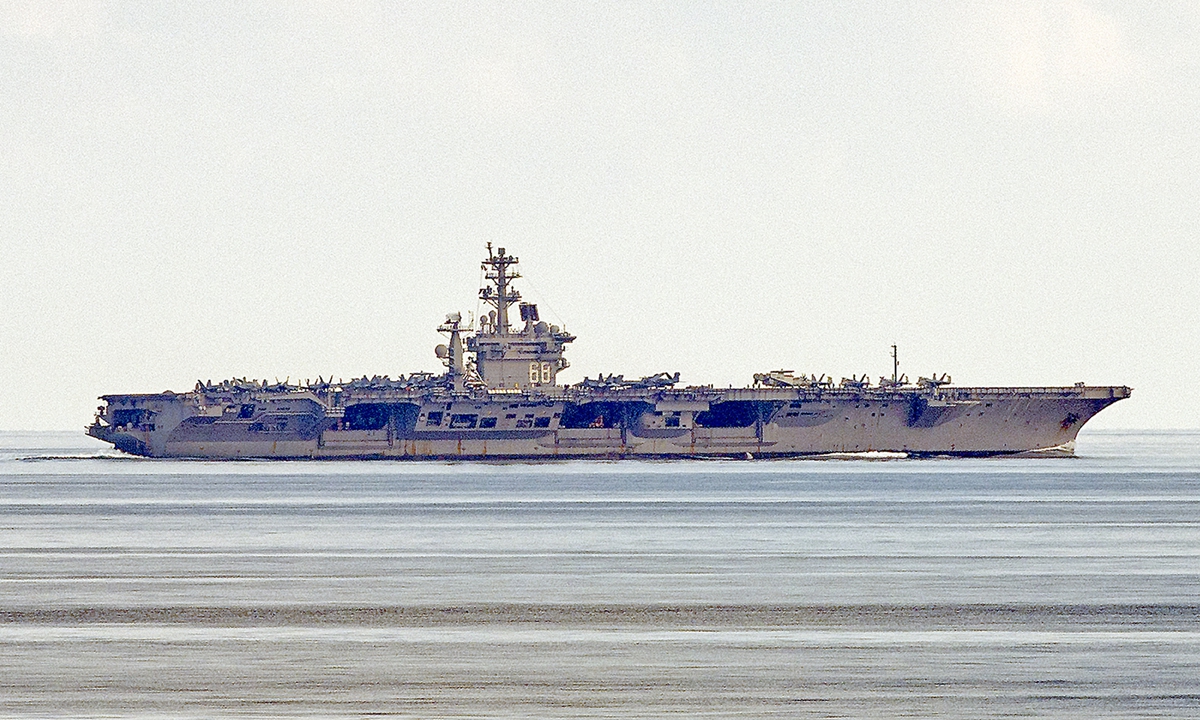By Liu Xuanzun and Xu Keyue

File photo of USS Nimitz (CVN-68) Photo: VCG
The US Pacific Fleet on Monday confirmed that two of its military aircraft crashed within less than an hour in the South China Sea on Sunday, with the cause of both incidents still under investigation. Multiple Chinese experts reached by the Global Times said on Monday that the incidents may have exposed the declining operational capability of the US Navy amid its extended global deployment.
Given that the US military has a record of accidents in the South China Sea in recent years, some Chinese experts believe that with the US military's global deployment strategy, its forces appear to have been under heavy load.
In response to media reports over a US military helicopter and a fighter jet crashed in the South China Sea in separate incidents within 30 minutes of each other, Chinese Foreign Ministry spokesperson Guo Jiakun said China is willing to provide necessary assistance in a humanitarian spirit if requested by the US side.
"I need to stress that the US aircraft crashed while conducting military drills in the South China Sea. The US has been flexing muscles by frequently sending military vessels and aircraft to the South China Sea. This is the root cause of security issues at sea and disruption to regional peace and stability," Guo said.
Two American military aircraft - an MH-60R Sea Hawk helicopter assigned to aircraft carrier USS Nimitz (CVN-68) and a US Navy F/A-18F Super Hornet fighter - crashed in the South China Sea on Sunday in two separate incidents, US Naval Institute's online news outlet USNI News reported Sunday evening. The US Pacific Fleet confirmed the crashes on Monday morning.
According to the US Pacific Fleet on X, at approximately 2:45 pm on Sunday, a US Navy MH-60R Sea Hawk helicopter, assigned to the "Battle Cats" of Helicopter Maritime Strike Squadron (HSM) 73 went down in the waters of the South China Sea while conducting operations from the aircraft carrier USS Nimitz (CVN 68). Search and rescue assets assigned to Carrier Strike Group 11 safely recovered all three crew members.
According to the US Pacific Fleet, following the incident, separately, at 3:15 pm, an F/A-18F Super Hornet fighter assigned to the "Fighting Redcocks" of Strike Fighter Squadron (VFA) 22 also went down in the waters of the South China Sea while conducting operations from Nimitz. Both crew members successfully ejected and were also safely recovered by search and rescue assets assigned to Carrier Strike Group 11, it said in the X posts.
The US Pacific Fleet claimed that all personnel involved are safe and in stable condition. The cause of both incidents is currently under investigation, it said.
Wei Dongxu, a Chinese military affairs expert, told the Global Times on Monday that the consecutive crashes of a carrier-borne helicopter and a carrier-borne fighter jet on the same day exposed that the US Navy's operational capability may have declined. This could include unreliability of its aircraft and equipment, as well as insufficient training of crew members.
The USS Nimitz is on the return leg of its final deployment before returning to the US West Coast, according to the USNI News report. The report noted that the carrier, its escorts and the embarked Carrier Air Wing 17 left from the West Coast on March 26. The carrier operated in the Middle East for most of the summer, as part of the US response the Houthi attacks on commercial shipping. The carrier entered the South China Sea on October 17, the report claimed.
The US military has a record of accidents in the South China Sea in recent years, According to media reports, in January 2022, an F-35C stealth fighter jet had a landing mishap on the deck of the USS Carl Vinson aircraft carrier and crashed in the South China Sea. In October 2021, the USS Connecticut nuclear-powered submarine struck an underwater object in the South China Sea.
Elsewhere in the world, in December 2024, a two-seat F/A-18F Super Hornet from the aircraft carrier USS Harry S. Truman was mistakenly shot down by the guided-missile cruiser USS Gettysburg over the Red Sea amid the US military's intensive operations on the Houthis, according to media reports.
Wei said that the US has been exhausting its resources to expand its military equipment for extended global deployments, but this has seemingly led to fatigue and declining morale of personnel, and its weapons and equipment may have not been well maintained.
Song Zhongping, another Chinese military affairs expert, told the Global Times on Monday that the US military has repeatedly flexed its muscles in the South China Sea to show off its military presence under the pretext of the so-called "freedom of navigation." But with the US military's global deployment strategy, its forces have been under heavy load.
Ding Duo, director of the Research Center for International and Regional Studies at the National Institute for South China Sea Studies, told the Global Times that the US Navy's aircraft carrier deployment in the South China Sea could be an attempt to conduct strategic deterrence to countries in the region, which runs counter to the common aspiration of regional countries for peace and development, and will not earn respect. Instead, they will accelerate the depletion of its strategic credibility.
The so-called "freedom of navigation" operations by the US military are essentially an attempt to undermine peace and stability in the South China Sea by leveraging its military superiority, Ding said, noting that the large number of warships and aircraft gathering in key waterways to conduct dangerous operations not only disrupts the safety of civilian navigation, but also significantly increases the risk of miscalculations.



